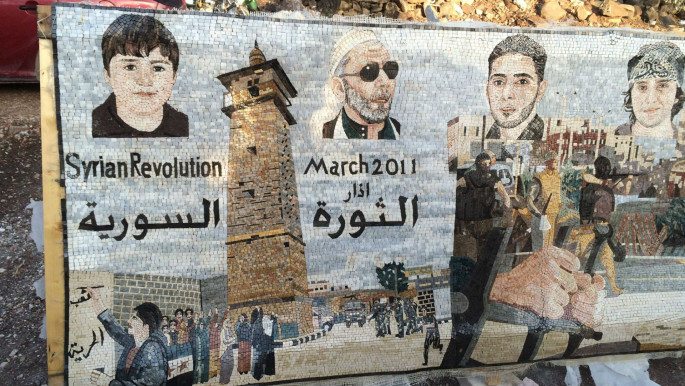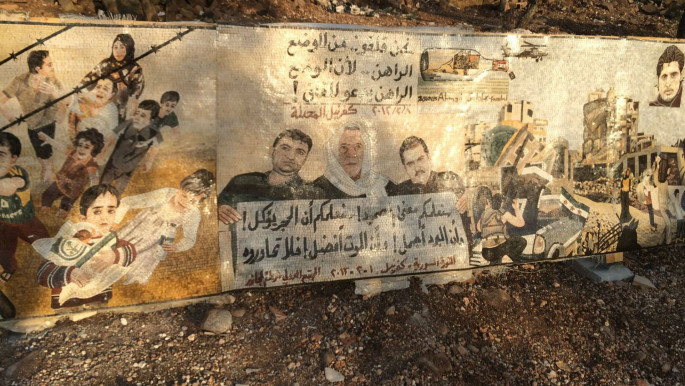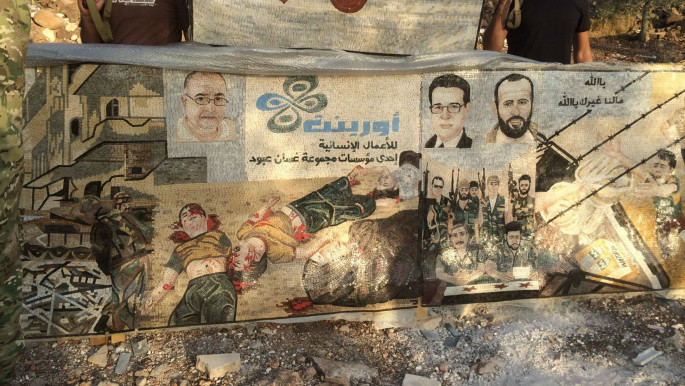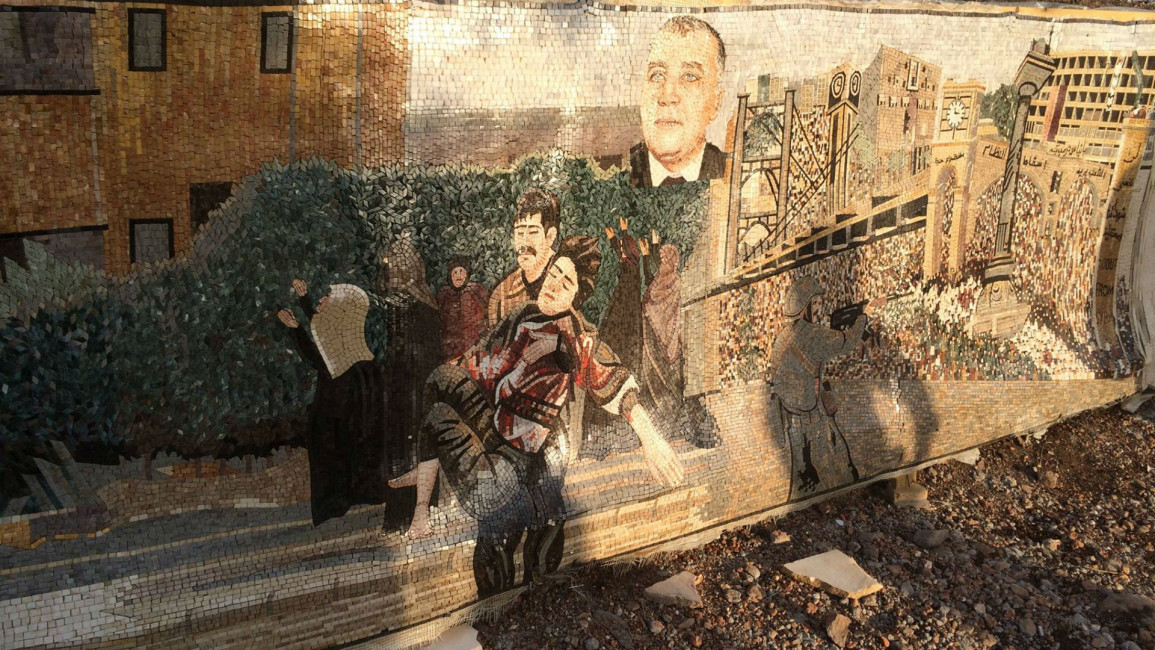
Stone art in the heart of the Syrian revolution
Stone art in the heart of the Syrian revolution
Culture: Kafrnabel in central Syria has become renowned for its humorous and tragic messages against the Syrian regime. This week, the city unveiled a powerful mosaic documenting Syria's four-year war.
3 min read
The 24-metre mosaic depicts turning points in Syria's four-year war [Supplied]
A million fragnments of stone have been used to tell the story of the Syrian war, from the first days of protests in March 2011 to its current tragic outcome, with 250,000 Syrians dead and millions more injured and homeless.
The 24-metre mosaic was unveiled this week in Kafrnabel, a city in Idlib province - central Syria - made famous for its brave opposition to the Syrian regime since the first day of the uprising.
Kafrnabel's latest artistic output is the work of 35 artists - including seven who suffered disabilities due to the war - and took two months to complete.
"The mosaic panel is a personal idea and aims to reflect the stages of the Syrian Revolution," said Abdullah Bayoush, manager of the Orient company in Kafrnabel.
Orient, which is behind the project, has throughout the war helped hundreds of activists and artists based in Syria, and is part of a pro-opposition TV station.
"Kafrnabel is a mountainous area, [so we used] natural stone colours when creating the mosaic panels. Kafrnabel is known as the mosaic city, because of the number of artists who work in this job."
Kafrnabel is known by Syrians as the "heart of the revolution".
People in the city have unveiled dozens of revolutionary banners throughout the war, featuring satirical comments and cartoons about regime brutality, Russian cynicism, and the West's apathy.
The images to be found within the mosaic show soldiers firing into the pro-democracy crowds - and the bloody consequences these acts of violence would have.
The first panel also honours Hamza al-Khateeb, a 13-year-old boy from Daraa in southern Syria, who was arrested and horrifically tortured to death by security forces in May 2011.
His killing intensified protests against the regime in Daraa city and sparked further demonstrations across Syria.
The wave of anger included the beginning of the armed uprising against Bashar al-Assad's regime, and the massacre of women and children by pro-Damascus forces at Houla, the chemical attack on Ghouta, the destruction of towns by regime barrel bombs, and the "death boats" to Europe.
It also depicts the popular pro-opposition Italian priest Father Paolo, who was abducted by Islamic State group forces in 2013.
Now the war has cost quarter of a million Syrian lives, the vast majority of whom were civilians, whose lives were cut short at the hands of the Assad government.
More than four million Syrians have fled abroad, while more than seven million have been been forced from their homes and remain, displaced, yet trapped inside the country.
The mosaic also brings in references to popular culture, such as the Johnny Depp film Pirates of the Caribbean, which have also played a role in Kafrnabel's revolutionary posters.
A workshop in the city has produced other stunning stone-studded art works throughout the war.
"[We wanted to spread] cultural awareness in the city that gave the Syrian revolution a special character," said Bayoush.
Orient is now hoping to set up workshops to help teach the art of mosaic-making across the region and support Kafrnabel residents making art in a time of war.
The 24-metre mosaic was unveiled this week in Kafrnabel, a city in Idlib province - central Syria - made famous for its brave opposition to the Syrian regime since the first day of the uprising.
Kafrnabel's latest artistic output is the work of 35 artists - including seven who suffered disabilities due to the war - and took two months to complete.
"The mosaic panel is a personal idea and aims to reflect the stages of the Syrian Revolution," said Abdullah Bayoush, manager of the Orient company in Kafrnabel.
Orient, which is behind the project, has throughout the war helped hundreds of activists and artists based in Syria, and is part of a pro-opposition TV station.
"Kafrnabel is a mountainous area, [so we used] natural stone colours when creating the mosaic panels. Kafrnabel is known as the mosaic city, because of the number of artists who work in this job."
Kafrnabel is known by Syrians as the "heart of the revolution".
 |
People in the city have unveiled dozens of revolutionary banners throughout the war, featuring satirical comments and cartoons about regime brutality, Russian cynicism, and the West's apathy.
The images to be found within the mosaic show soldiers firing into the pro-democracy crowds - and the bloody consequences these acts of violence would have.
The first panel also honours Hamza al-Khateeb, a 13-year-old boy from Daraa in southern Syria, who was arrested and horrifically tortured to death by security forces in May 2011.
His killing intensified protests against the regime in Daraa city and sparked further demonstrations across Syria.
The wave of anger included the beginning of the armed uprising against Bashar al-Assad's regime, and the massacre of women and children by pro-Damascus forces at Houla, the chemical attack on Ghouta, the destruction of towns by regime barrel bombs, and the "death boats" to Europe.
 |
It also depicts the popular pro-opposition Italian priest Father Paolo, who was abducted by Islamic State group forces in 2013.
Now the war has cost quarter of a million Syrian lives, the vast majority of whom were civilians, whose lives were cut short at the hands of the Assad government.
More than four million Syrians have fled abroad, while more than seven million have been been forced from their homes and remain, displaced, yet trapped inside the country.
The mosaic also brings in references to popular culture, such as the Johnny Depp film Pirates of the Caribbean, which have also played a role in Kafrnabel's revolutionary posters.
 |
A workshop in the city has produced other stunning stone-studded art works throughout the war.
"[We wanted to spread] cultural awareness in the city that gave the Syrian revolution a special character," said Bayoush.
Orient is now hoping to set up workshops to help teach the art of mosaic-making across the region and support Kafrnabel residents making art in a time of war.




